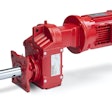
During a Surface Transportation Board (STB) hearing on March 15, theNational Grain and Feed Association (NGFA)said finalizing competitive (or “reciprocal”) switching rules pending at the STB would increase rail-to-rail competition for the benefit of agricultural shippers and for society at large.
NGFA Chief Economist Max Fisher testified on the STB’s proposal to revise competitive switching rules, which would allow shippers served by a single railroad to request bids from a nearby competing railroad. STB’s proposal has been pending since 2016.
“在一个高度很大程度上巩固和俘虏industry, this may be the best opportunity to create some semblance of rail-to-rail competition,” he said. “Many of NGFA’s members are captive to one railroad and have little bargaining power in the absence of rail-to-rail competition.”
Since 2017, when NGFA submitted its last set of comments on the proposal, the amount of grain transported by rail has been relatively steady and the trend of shuttering smaller train loading facilities and building larger facilities has continued, NGFA noted. Meanwhile, it remains difficult to locate facilities in places where more than one railroad can provide service.
“Agriculture’s suitability for alternative rail service through reciprocal switching has improved and its need for rail-to-rail competition remains,” Fisher said.
机顶盒目前的规定ns governing reciprocal switching were promulgated in 1985 by the Board's predecessor, the Interstate Commerce Commission. The regulations provide that reciprocal switching would only be prescribed if the agency determines that a railroad is engaging in activity considered “anticompetitive.” Under the Board’s proposal, there would be no need to show anticompetitive conduct. Rather, the Board would require the establishment of a switching arrangement if it is “practicable and in the public interest” or is “necessary to provide competitive rail service.”
NGFA submitted comments on Feb. 14 as part of the formal record urging the Board to require competitive switching for shippers and receivers that are within 100 miles of another railroad. During his testimony, Fisher noted that a recent survey of NGFA membership shows that more than half of NGFA members’ rail origin and destination facilities are located on a Class I railway within 100 miles of a second Class I railway.
“Consequently, a determination in the final rules that 100 miles is ‘within a reasonable distance’ of an interchange could potentially lead to increased rail-to-rail competition for a significant portion of grain shippers,” he said.
Read NGFA’s full comments on competitive switching.





















